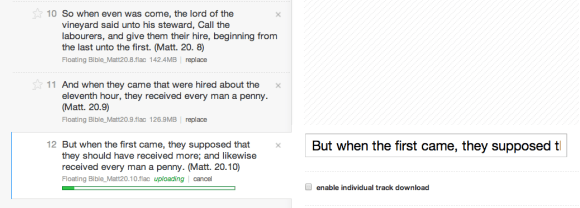8.45 am, and a visit to the chemists to process prescriptions. A grey, dank day brings out the worst in the town. The Protestant Reformer Martin Luther believed that demons occupied the ‘thick black clouds … and poisonous air’. Towards the end of his life, John Ruskin associated the dark skies and torporous climate in the North of England with an evil malaise. Perhaps we project upon the weather our state of mind:
I mixed down the files for Matt. 20.10 and uploaded the track for public access. Only another 16 to go:
Onward with the present Art/Sound lecture. I must complete 4,000 words of text by the end of the week, and a further 4,000 words every week until the beginning of term.
We had a lovely lunch (made from locally produced tortilla and cut meats) with our friends Alan and Pat Davey and an honoured guest, Mrs Eluned Thomas — one of the most gracious and wise women that I’ve had the privilege of knowing. I’d not seen her in many years. Had she lived in biblical times, Mrs ‘T.’ would probably have been considered a prophetess in the mould of Anna (Luke 2.36-8). During the 1980s, she ran a house in Cardiff for single female students. Understandably, Auntie Eluned (as she was called by ‘her girls’) drew to her door a succession of male callers on a regular basis … myself included:
Back to the Art/Sound lecture and a search for examples of Musique Concrète, beginning with Walter Ruttman’s seminal and engagingly silly Wochenende (1930).
In the evening I returned to the search, and tutored my younger son as he set off on his first foray into the world of analogue/digital recording and multi-tracking. It can be a rather steep learning at first. Fatherly advice: ‘Record as loudly as possible, without clipping; deploy the metronome; accept the prospect that days may pass before you lay down a track that’s even barely adequate; and always make one more attempt beyond what you consider to be your best effort’.













































